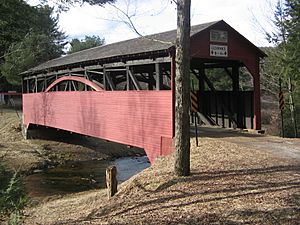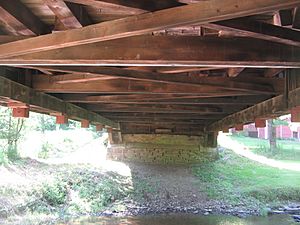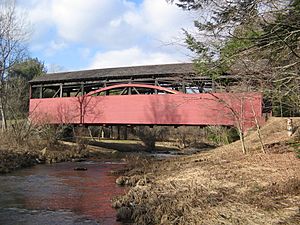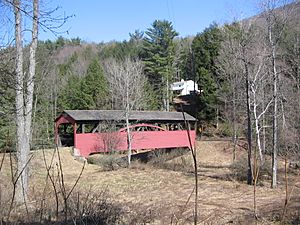Cogan House Covered Bridge facts for kids
Quick facts for kids Cogan House Covered Bridge |
|
|---|---|
 |
|
| Coordinates | 41°23′54″N 77°12′03″W / 41.39833°N 77.20083°W |
| Carries | Township 784 |
| Crosses | Larrys Creek |
| Locale | Lycoming, Pennsylvania, United States |
| Official name | Cogan House Covered Bridge |
| Other name(s) | Buckhorn |
| Named for | Cogan House Township |
| Maintained by | Lycoming County |
| NBI Number | 417208078401120 |
| Characteristics | |
| Design | National Register of Historic Places |
| Total length | 94.2 ft (28.7 m) |
| Width | 19.6 ft (6.0 m) |
| Height | 8.5 ft (2.6 m) |
| Load limit | 3 tons (2.7 t) |
| History | |
| Constructed by | Valentine Meyers (or Meyer) |
| MPS | Covered Bridges of Bradford, Sullivan and Lycoming Counties TR |
| NRHP reference No. | 80003567 |
| Added to NRHP | July 24, 1980 |
| Lua error in Module:Location_map at line 420: attempt to index field 'wikibase' (a nil value). | |
The Cogan House Covered Bridge is a special kind of covered bridge in Lycoming County, Pennsylvania. It crosses Larrys Creek in Cogan House Township. This bridge was built in 1877 and is about 94 feet (28.7 m) long. It uses a design called a Burr arch truss.
In 1980, the bridge was added to the National Register of Historic Places, which means it's an important historical site. It also had a big repair project in 1998 to keep it strong. The bridge is named after Cogan House Township and the nearby village. It's also known by several other names, like Buckhorn, Larrys Creek, Day's, and Plankenhorn.
The Cogan House Covered Bridge was built by a millwright, who is someone who designs and builds mills. He put the wooden frame together in a field first, then took it apart and rebuilt it at the bridge site. This bridge was the only one on Larrys Creek to survive a huge flood in June 1889. It was one of the few bridges left standing in the whole county after that flood.
Long ago, the bridge was very busy with wagons carrying goods from tanneries (places that make leather) and sawmills. But by the early 1900s, most of the trees in the area had been cut down. This meant the tanneries and sawmills closed, and the bridge became much quieter.
Today, many of the forests around the bridge have grown back. The bridge is a one-lane road in a quiet valley, so it doesn't get much traffic. It is the oldest and longest of the three covered bridges still standing in Lycoming County. Even after its repairs, in 2009, experts said it needed more work to be in top condition.
Contents
Why So Many Names?
The Cogan House Covered Bridge is about 1.4 miles (2.3 km) south of Pennsylvania Route 184 on Campbell Road. Its official name on the National Register of Historic Places is "Cogan House Covered Bridge." This name comes from the township and village of Cogan House, which are northeast of the bridge.
How Cogan House Got Its Name
Cogan House Township and the village are named after David Cogan. He settled near Larrys Creek in 1825. For many years, Cogan was one of the only settlers there. He eventually got tired of living alone in the wilderness and left his home in 1842. Another neighbor, Carter, also left. Their empty houses were then used by hunters and travelers, and people started calling the area "Cogan's House." Cogan House Township was officially created on December 6, 1843.
The Buckhorn Bridge Name
Since the bridge was repaired in 1998, the Lycoming County Commissioners have officially called it the "Buckhorn Covered Bridge." This name comes from the bridge's location at the bottom of Buckhorn Mountain. It was also the road that led to the old village of Buckhorn. You can see this name on the official plaque that the commissioners put up after the restoration. This is interesting because the National Register of Historic Places uses a different name!
Other Names for the Bridge
- Larrys Creek Covered Bridge: Historian Milton W. Landis uses this name because the bridge crosses Larrys Creek. The creek itself is named after Larry Burt, who was the first settler at the creek's mouth in 1769.
- Day's Bridge: This is another name that people have used for the Cogan House Covered Bridge.
- Plankenhorn Bridge: This name also appears on lists of covered bridges in Lycoming County. While it's not directly stated, this name likely refers to the Cogan House Covered Bridge because it's described as still standing on Larrys Creek and being north of a bridge in Mifflin Township, which matches the Cogan House bridge's location.
Bridge History and Building
Why Covered Bridges?
The very first covered bridge in the United States was built in Philadelphia, Pennsylvania, in 1800. Pennsylvania used to have more covered bridges than any other state, with an estimated 1,500 between 1830 and 1875. In 2001, Pennsylvania still had the most historic covered bridges, with 221 remaining.
Covered bridges were a step between stone bridges and modern steel bridges. In the 1800s, wood was easy to find in Pennsylvania. However, wood doesn't last long when it's exposed to rain, snow, and sun. The roof and sides of covered bridges protected the wooden parts. This protection allowed some of these bridges to last for over 100 years!
The Cogan House Covered Bridge uses a "Burr arch truss" design. This means it has a strong arch that helps carry the weight, along with many vertical and diagonal wooden posts. This design makes the bridge much stronger and stiffer than if it used just one of those parts alone.
Before the Bridge Was Built
Before the bridge, there was a shallow place in the creek called a ford where wagons could cross. Wagons carrying leather and other goods used this ford. Other traffic came from sawmills. People needed to cross Larrys Creek to get to different towns or railroads.
However, the ford was often impossible to cross in winter, bad weather, or when the water was high. So, in September 1876, people from Cogan House Township asked the county to build a bridge. They said the township couldn't afford it alone. The county agreed, and on January 23, 1877, they approved building the bridge.
Building the Bridge
The Cogan House Covered Bridge was built in 1877 by Valentine Meyers, a millwright from a nearby town. The wood for the bridge was pine, cut from nearby forests. Ox carts brought the logs to a sawmill not far from the bridge site. The largest pieces of wood used in the bridge were up to 16 feet (4.9 m) long.
Meyers built the bridge in a very interesting way. He first put the entire wooden frame together in a field next to the sawmill. As each new piece was cut, it was bolted into place. If a piece didn't fit, they would cut a new one. For the curved parts of the Burr arch, they marked the curves with chalk and then carefully cut the wood by hand with a saw.
Once the whole frame was built in the field, it was taken apart. The pieces were loaded onto the same ox carts and taken to the bridge site. There, the frame was put back together on the stone supports (called abutments). Bolts held the big pieces together, while smaller parts were nailed.
The Cogan House Covered Bridge is about 94 feet (28.7 m) long. The road inside is about 14 feet (4.3 m) wide, which is only wide enough for one car at a time. The bridge can hold a maximum weight of 3.0 short tons (2.7 t). The height limit for vehicles is 8 feet 6 inches (2.6 m).
The bridge sits on its original stone supports, which have been made stronger with concrete. The bridge floor is made of wooden planks. The sides of the bridge are made of pine boards, which stop about 3 feet (0.9 m) below the roof. In 1998, the bridge was painted red. Before that, it was unpainted and blended into the forest. The roof was originally covered with wooden shingles.
How the Bridge Has Been Used and Repaired
The Cogan House Covered Bridge was the only bridge on Larrys Creek that survived a huge flood on June 1, 1889. This flood washed away most other bridges in Lycoming County. A large maple tree fell and created a natural dam just upstream from the bridge. This dam blocked debris and pushed the main force of the floodwaters away from the bridge, saving it! The same storm also caused the famous Johnstown Flood, which killed over 2,200 people.
After the flood, the roads that led to the bridge were not fully rebuilt. Also, all the old-growth forests that supplied the tanneries and sawmills were cut down within a few years of the flood. Without timber, these businesses closed, and the local villages, like Buckhorn, disappeared. This meant much less traffic for the bridge.
As of 2011, the Cogan House Covered Bridge is the oldest and longest of the three covered bridges from the 1800s that are still standing in Lycoming County.
Repairs and Restoration
The bridge had some "needed repairs" in 1964. Its stone supports were also made stronger with concrete before 1966. In 1980, it was added to the National Register of Historic Places. In 1981, it was painted and treated to protect the wood.
In 1998, the Lycoming County Commissioners had the bridge fully "rehabilitated" (restored) for about $105,493. Workers replaced some of the main wooden beams with treated pine. They also replaced the old siding with new white pine boards. The roof was rebuilt with new cedar shingles. The floor of the bridge was still strong and needed only a few repairs. The bridge was painted red, and a stone pillar was built with plaques to mark the restoration and its historical importance.
Because the bridge is a historic site, the Pennsylvania Historical and Museum Commission had to approve the renovation. Money from the Pennsylvania Department of Transportation (PennDOT) and the Federal Highway Administration (FHWA) helped pay for the work. A special ceremony was held on October 30, 1998, to celebrate the bridge's reopening.
In August 2000, an inspection showed that one of the bridge's wooden arches was damaged. It was thought that a propane delivery truck, which was too heavy, caused the damage. The bridge was still safe to use, and repairs were made for $6,300.
Even with the repairs, in 2009, experts said the bridge's structure needed more work. They found that the bridge's main parts were in "poor" condition. They also noted that the railings were not up to modern safety standards. The overall condition was described as "basically intolerable requiring high priority of corrective action." In 2006, it was estimated that it would cost $143,000 to improve the bridge.
Today, the bridge is still used, even though the public dirt road to it ends in a dead end on the east side. A private road continues from there to a hunting camp. The bridge has a speed limit of 10 miles per hour (16 km/h) and about ten vehicles cross it each day. Even though it's in a quiet area, it's considered a beautiful and historic place worth visiting.
Images for kids
See also
 In Spanish: Puente cubierto de Cogan House para niños
In Spanish: Puente cubierto de Cogan House para niños






